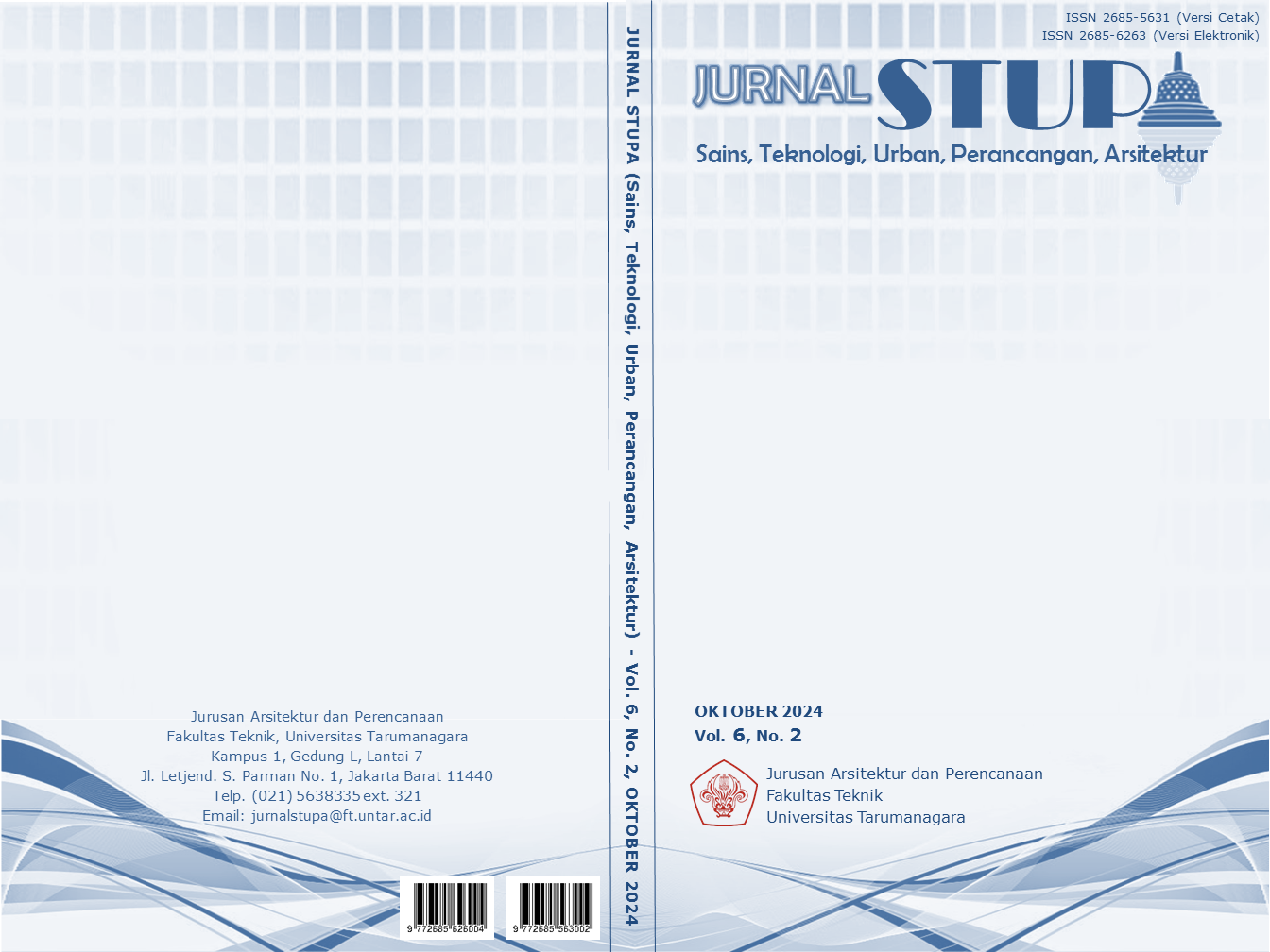DESAIN MODUL HUNIAN KHUSUS SENIMAN
Main Article Content
Abstract
The Ismail Marzuki Park Art Center has become an area for artists to work and exhibit. In 2019-2024, the art center is undergoing revitalization, but artists and culturalists are protesting this change, one of which is the change of the artist's special wedding function to the hotel. This leads to a loss of identity in the area because the artists who were supposed to revive the area of the art center now disappear and set up their own posko with a badge. In fact, artists with a wide range of skills also need space to work. The purpose of writing this journal is to study, understand, and explore the humane modules that support the artist in creating, preserving, and displaying or showcasing the work of the artist. In addition, this space can also accommodate tools and materials other than the reactions of the artist with his art in the space, so that the discovery of sufficient space loads can be achieved. It is obtained and studied through spatial study methods, literature studies, or other mediators that can support it. Therefore, a number of space indicators are suitable for artists with direct analysis methods on self-made two- or three-dimensional space image modules. As a result, there are some recommended spaces to be used in the artist's special dwellings.
Keywords: Art; Artist; Creation; Space
Abstrak
Pusat seni Taman Ismail Marzuki telah menjadi area untuk berkarya dan menampilkan karya para seniman. Pada tahun 2019-2024 pusat seni ini mengalami revitalisasi, namun para seniman dan budayawan memprotes perubahan ini salah satunya adalah karena perubahan fungsi wisma khusus seniman menjadi hotel. Hal ini menimbulkan Hilangannya identitas pada kawasan karena seniman yang semestinya menghidupkan area pusat seni, kini menghilang dan mendirikan posko sendiri dengan tagar savetim. Sebenarnya seniman dengan berbagai macam keterampilan yang dimiliki juga membutuhkan ruang untuk berkarya. Tujuan penulisan jurnal ini adalah untuk mempelajari, memahami, dan mengeksplorasi modul hunian yang mendukung seniman untuk berkreasi, menyimpan, dan memajang atau menunjukkan karya yang telah dibuat oleh sang seniman. Selain itu, ruang ini juga dapat mengakomodasi alat-alat dan bahan-bahan selain itu aksi-reaksi seniman dengan seninya di dalam ruang tersebut, agar penemuan terhadap muatan ruang yang cukup dapat tercapai. Hal ini didapatkan dan dipelajari melalui metode studi ruang, kajian literatur, maupun mediator-mediator lain yang dapat mendukung. Oleh karena itu, dibuat beberapa Indikator ruang yang cocok untuk seniman dengan metode analisis langsung pada modul gambar ruang yang dibuat sendiri secara dua maupun tiga dimensi. Hasilnya ada beberapa ruang yang direkomendasikan untuk digunakan pada hunian khusus seniman.
Article Details

This work is licensed under a Creative Commons Attribution-NonCommercial-ShareAlike 4.0 International License.
This work is licensed under a Jurnal Sains, Teknologi, Urban, Perancangan, Arsitektur/ STUPA Creative Commons Attribution-NonCommercial-ShareAlike 4.0 International LicenseReferences
Clark, Kim & Baldwin, Carliss. (2002). The Option Value of Modularity in Design: An Example from Design Rules, Volume 1: The Power of Modularity. SSRN Electronic Journal. 10.2139/ssrn.312404.
Detikcom.(2022). Taman Ismail Marzuki: Sejarah, Lokasi, Fasilitas, Retrivied from detikNews: https://news.detik.com/berita/d-6177619/taman-ismail-marzuki-sejarah-lokasi-fasilitas-cara-berkunjung.
Placeness.(2015). Placeness,Place, Placeless, Retrivied from placeness: Overview of Non-Place/Placelessness Ideas | PLACENESS, PLACE, PLACELESSNESS
Puspitasari, E.P. dkk (2022). Kajian Tipologi Pola Ruang Hunian Vertikal Untuk Mahasiswa Di Margonda Depok, Studi Kasus: Apartemen Taman Melati Margonda 2 Depok.Journal of Architecture and Development 3(1). Pp. 67-78. https://doi.org/10.37253/jad.v3i1.6307
Sutanti, P.P.B, & Pratiwi, W.D. (2022). Analysis of the Tourism Business District Concept in the Cikini Area of Jakarta. Jurnal Lingkungan Binaan Indonesia. 11(4).pp. 188-198. https://doi.org/10.32315/jlbi.v11i4.17



